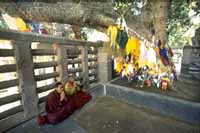











|
This FAQ is designed to clarify some of the terms used in the translations of Buddhist texts and used occasionally in the website. It is not intended to be definitive nor comprehensive but may be helpful as a guide to understanding for those who are new to the nomenclature. Many of these terms are taken from the original Sanskrit.
In some cases, it is completely impossible to do justice to the questions in the brief manner required in an FAQ; but for the purposes of this website, it is hoped that more advanced visitors will try to understand that the best intentions are there and it is the sincere hope of the author to inspire the novice inquirer to learn more from deeper texts and thus do his modest part in spreading the Dharma.
Contents
-
What is "Buddhism"?
Buddhism is a religion that, historically (meaning accepted Western history), was started by Shakyamuni, commonly known as "The Buddha". Superficially, anyone can declare themselves a Buddhist, albeit a novice, by "taking refuge". However, an understanding and commitment to the principles the action entails is required to be a good Buddhist. Buddhism is one of the great religions today and its key characteristic is compassion towards all sentient beings.
Top of page
-
What do "Buddhists" believe?
The Buddha commonly refers to Shakyamuni Buddha, who was born Siddhartha Goutama, a historical figure who was Prince of Sakyans. He gained enlightenment at 35 and went on to teach the principles to lead others to this peerless state about 2500 years ago thereby founding Buddhism. Shakyamuni means capability and kindness.
Top of page
- What is "Buddhahood"?
However, the word "Buddha" actually means "enlightened" or "awakened" one, and Buddha is also a state of being. It is possible for all sentient beings to achieve such a state, sometimes called Buddhahood. Thus achieving Buddhahood is reaching enlightenment and vice versa.
Top of page
Top of page
Top of page
-
How does one become a "Buddhist"?
Superficially, anyone can declare themselves a Buddhist, albeit a novice, by "taking refuge". However, an understanding and commitment to the principles the action entails is required to be a good Buddhist. Buddhism is one of the great religions today and its key characteristic is compassion towards all sentient beings. There are many beings who have achieved enlightenment and several, the so-called historical Buddha's, have been born in the past, and more will be born in the future. Thus, the last Buddha, Shakyamuni was one of the historical Buddha's; and Maitreya will be the next Buddha, who will revive and continue the teachings of Shakyamuni.
Top of page
- Who is "Maitreya"?
Maitreya literally means friendly and benevolent. It comes from the Sanskrit word "maitri" meaning universal love. Maitreya will be the next Buddha in our world. He is now preaching in Tushita Heaven. He is popularly represented as the fat laughing Buddha but this image may have no definitive significance. This website has many texts dedicated to the Maitreya.
Top of page
- What is the "Dharma"?
This Sanskrit word means truth, or law (but its meanings are very diverse) and refers to the teachings of the Buddha. It has been extended to mean anything Buddhist since the principles of the teachings since they are all encompassing, being a profound perspective on the nature of reality, tangible and intangible.
Top of page
- What is the "Sangha"?
Originally, the Sangha were the first followers of the last Buddha, Shakyamuni. Since, it has been popularly extended to include all those who have taken the vows to be a Buddhist monk.
Top of page
- What is Bodhi?
Enlightenment, or Bodhi, is the ultimate goal of being a Buddhist... not just for oneself but for all sentient beings.
Top of page
- What is enlightenment?
Enlightenment is the ultimate state of knowing the true nature of all things. To achieve it, it is necessary to be free from all obscurations and negative karma, where we are in total control of minds and actions, enabling us to have an infinite capacity to help other sentient beings. In this state, we are free from all suffering since all suffering arises out of obscurations and negative karma. To achieve enlightenment is to achieve Buddhahood and become a Buddha oneself.
Top of page
- What is Karma?
Karma means action, deed, moral duty, or effect. Karma is action which causes future experience, good or bad. It is also the intangible essence of each being which survives death for further rebirth. It is one of the key ideas in Buddhism giving rise to the Buddhist perspective regarding destiny and luck. It holds the key to understanding how one's actions result in future experiences and of course how our current predicament is a result our previous actions. A fuller introduction to this key concept is available on another page.
Top of page
- What are obscurations?
Obscurations are influences which prevent us from seeing the true path towards enlightenment. Advanced Buddhist theory is very specific what they are and what they can result in. These are beyond the scope of this website. However, we all have an intuitive idea of what they are: things like anger, desire, greed, extremes of emotion, which prevent us from being objective and rational in our actions. The very same things can also corrupt our rationale such that we no longer see them for the obstacles to clear thought that they are.
Top of page
- What are pujas?
Pujas is name given to the wide variety of Buddhist devotional ceremonies. The word itself comes from the root meaning 'a flower' and probably developed from the custom of offering the Buddha flowers on his arrival.
Its value of the practice is the reinforcement of commitment, and thus enhancement of the effectiveness of practice of the Dharma. Pujas can be long and elaborate and, in some cases, are believed to have a magical power. They can vary from simple expressions of devotion to practices designed specifically to induce wealth, long life, help from the gods, or spiritual qualities.
Top of page
- Who are the sentient beings?
Sentient beings include all people and animals. Buddhist theory would also include those beings who live in other realms believed to exist in parallel with our own world. These include both blessed realms, like a kind of heaven and suffering realms, like a kind of hell. Incidentally, this realm, the realm of humans is considered a suffering realm.
As people, we have the additional, enviable ability to choose to do good or harm - something which the majority of beings are unable. Thus our human incarnation is considered a blessing which we should not waste since there is no certainty we can retain this incarnation in future lifetimes.
Top of page
- What is a Stupa?
 A modern stupa typically looks like the picture on the left. When the Buddha died, in keeping with traditional ceremony for royal and holy persons, he was cremated, and his ashes were divided into eight portions and buried under mounds raised in his home town and at seven other locations. An umbrella, the symbol of royalty, was placed on the top of each mound. These first stupa's were seen as symbols of the Buddha's presence and soon became objects of devotion. Legend says that King Ashoka opened these stupa's, further broke the ashes into 84,000 parts and built a stupa over each part. In later stupa's, the mound was modified into a solid dome and the umbrella into a spire. Sometimes the structures were enlarged to huge dimensions, and decorated with sculptures and paintings. A modern stupa typically looks like the picture on the left. When the Buddha died, in keeping with traditional ceremony for royal and holy persons, he was cremated, and his ashes were divided into eight portions and buried under mounds raised in his home town and at seven other locations. An umbrella, the symbol of royalty, was placed on the top of each mound. These first stupa's were seen as symbols of the Buddha's presence and soon became objects of devotion. Legend says that King Ashoka opened these stupa's, further broke the ashes into 84,000 parts and built a stupa over each part. In later stupa's, the mound was modified into a solid dome and the umbrella into a spire. Sometimes the structures were enlarged to huge dimensions, and decorated with sculptures and paintings.
Nowadays, the word stupa includes similar structures those built over relics of the Buddha or a saint, those containing an object used by the Buddha or a saint, those commemorating an important event in religious history and those built as an act of devotion. Today, a stupa is one of the primary objects of devotion.
Top of page
- What is prostration?
A prostration is an action that is somewhat similar to a press-up. The initial position is standing, holding ones hands together (as in prayer) at the top of ones head, moving to the forehead, moving to the neck then to the breast, then one crouches, reaching forward with the hands to the floor for support, lowering oneself to the ground (face down), before bringing ones hands to clasp above the head (as in prayer) and then returning rapidly to the standing position.
This action is usually repeated a number of times and used in conjunction with the recital of prayer, particularly the recital of taking refuges. In these days of emphasis on ego and the self, it is a symbol that one is giving up the self, and embracing the Buddhist principle to act for the good of others. By repeating the action, this frame of mind is created and reinforced, and through this, it is hoped to realize a more altruistic society which in turn leads all people closer to the ultimate goal of enlightenment.
Top of page
- What is "taking refuge"?
To the Buddhist, taking refuge is the basic act of becoming and confirming that one is a Buddhist. It consists of repeating the following prayer, in whatever language, three times:
I take refuge in the Buddha
I take refuge in the Dharma
I take refuge in the Sangha
As with any prayer, it is not the repeating of mere sounds, but the belief and understanding of the commitment behind the words that makes the action effective. The prayer is a basic commitment to the Buddha as the teacher, the principles held in his teachings, and the Sangha who continue to spread these teachings.
Top of page
- What is "Zen Buddhism"?
- What is "Mahayana Buddhism"?
Mahayana means "great vehicle" and is one of the schools of Buddhism which prevalent in China, Korea, Japan, Mongolia, Tibet and other places in the Far East. It is also called Northern Buddhism and Zen Buddhism is one of its schools which has become popular in the West. In India, Mahayana succumbed to the spread of Hinduism after the 9th century AD. Mahayana is described as seeking Buddhahood and transforming beings, thus self-benefiting, for the benefit of the others.
It evolved from Savakayana between the 1st century BC and the 2nd century AD, probably in response to a combination of factors including the continued development of the implications of what Buddha had taught, the shift in emphasis from meditation to philosophical contemplation, accommodating the needs of the lay community, and the need to respond to the challenge of Hinduism.
Top of page
- What is a "Bodhisattva"?
A Bodhisattva is a being destined to Buddhahood. It is composed of the words, Bodhi, and Sattva (sentient and conscious. The Bodhisattva's goal is the pursuit of Buddhahood for all sentient beings, and in so seeking, his own enlightenment will be achieved. He will sacrifice himself to save the others and has forsaken all forms of egoism and is devoted to help others.
Top of page
- Who is "Brahma"?
- What is a "Brahmin"?
Brahmin refers to the priest caste, the highest of the four Indian Castes at the time of Shakyamuni. These castes were social divisions defined by the predominant religion at the time of the Buddha, Brahmanism, which worshipped the god Brahma, the first god of the Hindu triad of gods who is credited with the creation of the Universe. Buddha himself was born into one of the higher castes, the warrior caste. His teachings criticized this system and ridiculed the priests for calling themselves superior saying "Birth does not make one a priest or an outcaste. Behavior makes one either a priest or an outcaste". Buddhism allowed all people to join the Sangha, unlike Hinduism which was to supercede Buddhism as India's dominant religion after the 9th century.
Top of page
- Who was King Ashoka?
King Ashoka was The third emperor of India's Mauryan dynasty and the first powerful monarch to embrace Buddhism. He came to the throne in 270 BC. In 260 BC his armies attacked Kalinga (modern Orissa) to expand the Mauryan empire. The campaign, though successful, resulted in such horrific loss of lives that Ashoka decided to renounce war forever. He converted to Buddhism and began a moral, spiritual and social renewal within his empire. Sweeping humanitarian reforms, useful public works, a new foreign policy of peaceful co-existence, and wildlife reserves were established.
All religions were promoted, especially Buddhism. The Sangha was purified and unified, the third Council was convened and Buddhist missionaries were sent throughout abroad as far west as Cyrene, Egypt, Syria, and Macedonia. He died 232 BC and his many legends about his life and good deeds sprung up. His importance in spreading Buddhism throughout India and his humanitarian influence on monarchs throughout Asia through his tolerant humane style of government cannot be understated.
Top of page
- What is a "Bodhi Tree"?
 This was the name given to the fig tree at Bodhgaya under which the Buddha sat on the night he attained enlightenment. It has come to refer to all such trees, whose botanical name is Ficus Religiosa, which have become objects of worship. Apparently, King Ashoka's daughter took a cutting of the original tree to Sri Lanka where it still grows in the island's ancient capital of Anaradapura. This was the name given to the fig tree at Bodhgaya under which the Buddha sat on the night he attained enlightenment. It has come to refer to all such trees, whose botanical name is Ficus Religiosa, which have become objects of worship. Apparently, King Ashoka's daughter took a cutting of the original tree to Sri Lanka where it still grows in the island's ancient capital of Anaradapura.
The original at Bodhgaya was destroyed by in the 2nd century BC and the tree planted to replace it, probably an offspring, destroyed at the beginning of the 7th century AD. The tree that grows at Bodhgaya today was planted in 1881 by a British archaeologist after the previous one had died of old age a few years before. Many Buddhist temples have Bodhi trees growing in them which are or are believed to be offspring of the one from Anaradapura and their worship forms an important part of popular Buddhist piety.
Top of page
- What is "Hinayana Buddhism"?
- What is "Savakayana Buddhism"?
- What is "Theravada Buddhism"?
Theravada Buddhism is the only Savakayana school of Buddhism that still flourishes. Savakayana means the Vehicle of the Hearers and originates from the way Buddhism was spread in its first 300 years, by oral transmission. It was introduced into Sri Lanka at the time of King Ashoka (approximately 250 BC) and later spread from there throughout South-East Asia. The Savakayana as represented by the Theravada school is characterized by adherence to the earliest versions of the Buddhist teachings and by an emphasis on Vinaya by monks.
It was later called Hinayana meaning the "little" or "narrow" vehicle referring to its strictness. Theravada is still found in Sri Lanka and Burma, and in Thailand. Today, Theravada has gained many new adherents in India, Malaysia, Singapore and particularly in Indonesia. It has also gained a significant following in the West.
Top of page
- What is a "Sugata"?
- What is a "Tathagata"?
These are some of the Ten Titles of Buddha, each of which represent one the characteristics of Buddha. The ten titles are:
- Tathagata - the Thus Come Ones
- Arhat - worthy of offerings
- Samyak-sambuddha - of proper and universal knowledge
- Vidyacarna-sampauna - perfect in understanding and conduct
- Sugata - skilful in leaving the world through liberation
- Lokavid - perfect and complete understanding of all worldly Dharma
- Anuttara - unsurpassed knights
- Purusa-damya-sarathi - taming heroes
- Sasta deramanusyanam - teachers of gods and people
- Buddha-lokanatha or Bhagaran - Buddha, the World Honored Ones
Top of page
- Who is "Avalokiteshvara"?
- Who is "Chenresig"?
- Who is the "Compassionate Buddha"?
- Who is "Kuan Yin"?
Avalokiteshvara is the Sanskrit word for the Bodhisattva who Hears the Sounds of the World. He rescues all beings by hearing their voices of suffering and cries for help. He is the one with the greatest compassion and mercy. He is also known as Chenresig in Tibetan and Kuan Yin in Chinese traditions. Avalokiteshvara is known to take many forms or aspects. The Kuan Yin aspect is represented as an elegant goddess and is one of the most popular Bodhisattvas in the Chinese Tradition. Chenresig is often represented as a 1000 armed figure with an eye on each palm signifying his ability to see all and thereby extend his services to the aid of all sentient beings. In the scriptures, he will be the next Buddha in the spiritual realm (Pure Land) created by one of the Buddha's, Amitabha Buddha, thus he is also called the Compassionate Buddha.
Top of page
- Who are the "Taras"?
The legend goes that Avalokiteshvara, in attempting to accomplish the task of rescuing all sentient beings from suffering, grew tired and despaired. At that moment, he cried two tears that fell to the ground and grew as lotuses. When the flowers blossomed, the Bodhisattvas, Green Tara and White Tara were emerged. Both the Taras are always depicted as female and represents the idea that it is equally possible to attain enlightenment regardless of gender. They are also known as the "Mothers of Compassion". The Green Tara is always depicted as one foot outstretched from the meditation posture indicating her readiness to come to the aid of suffering beings.
Top of page
- What are "mantras"?
Mantras are sacred texts which are usually used as incantations, chanted or repeated inwardly in meditation.
Top of page
- What are the "Vedas"?
Vedas refers to any one or all of the four sacred Hindu texts upon which the ancient Hindu religion is based.
Top of page
- What is "Vinaya"?
Vinaya refers to the original rules laid down by Buddha to his followers, the Sangha, and which are detailed in the first of the four Pali texts, Vinaya-Pitaka. Vinaya is the fourth of the five primary subjects for the Buddhist teacher or Geshe degree. This subject concerns itself mainly with disciplinary laws and the laws of cause and effect.
Top of page
- What does it mean that all things are truly unborn?
The concept of unborn has many different levels. Our mind-stream is unborn for it has spent countless lifetimes in the cycle of death and rebirth. All things that arise and depart in samsara are truly unborn for they do not rely on solely one root causation. It is a phenomena that is at a constant flux. The latter is a Dzogchen concept.
Top of page
- How is voidness the absolute spirit of enlightenment?
Voidness or emptiness is the ultimate realization of cause and effect. It is the ultimate realization of the lack of inherent existence of all objects (unborn). Everything is a collection of aggregate parts that have come together through interdependent origination and will pass due to impermanence. Impermanence is also an unborn concept, it just happens. No-birth is a term used to explain the nature of Nirvana. Being in this state means that you no longer have attachment to impermanent things.
Top of page
Top of page
- What is the path of the universal vehicle?
Mahayana is the path of the Universal Vehicle as opposed to the individual vehicle, Hinayana. Hinayana=individual emptiness, individual enlightenment. Mahayana=universal emptiness (of all objects and phenomena), universal enlightenment.
Top of page
Top of page
- What are the three educations?
Three educations: moral, meditational & intellectual. Do you remember how I teach the Eightfold path as three sections.
Top of page
Top of page
Top of page
Top of page
Top of page
Top of page
Top of page
- What are the four imeasurables and the six transcendencies?
Four Imeasurables - May all beings be have happiness and the causes of happiness (unconditioned love) May all beings be free from suffering and the causes of suffering (unconditioned compassion) May all beings dwell in peace and ease with out attachment or aversion to one another, develop equality (unconditioned giving) May all beings never be separated from the happiness that is beyond all suffering (unconditional joy)
Six transcendances: giving, morality, patience, effort, focus, wisdom
Top of page
Top of page
Top of page
Top of page
Top of page
Top of page
- What are the 37 enlightenment accessories?
Faculties that are developed. Four focuses of mindfulness, four
abandonment's, four magic powers, five spiritual faculties, five strengths, seven enlightenment faculties, and the noble eightfold path. Buddhists have a lot of lists
Top of page
- What is the Bhumi Puja?
It is the Buddhist ceremony used to purify a geographical location. Usually done prior to the construction of shrines or temples.
Top of page

Top of page
-
What is a Vajra?
A Sanskrit word, literally meaning `diamond' or `thunderbolt', the vajra symbolized the supreme power of the divine Indra, King of the Gods, in Vedic Hinduism. It was transvalued as a symbol of compassion in Mahayana Buddhism. In esoteric sects, the vajra represents the victorious power of knowledge over ignorance. It is a symbol used in ritual or found in the hands of various Mahayana deities. They represent either the clear insight (such as a lighting bolt cutting through a darkened sky), or pure understanding (such as the clarity of a diamond).

Top of page

Top of page

Top of page
-
What is a Malla?
The Tibetan Buddhist mala, or beaded rosary aims to practitioner in counting mantra recitations while also helping one to focus concentration and awareness. As one works the malas' beads with one is fingers, recites the mantra and visualizes the deity, one is at once involving the body speech and mind. A mala is composed of 108 beads and a vase or guru bead. Each bead corresponds to one of the 108 virtues of the Buddha.

Top of page
-
What is a Purba?
A purba is a ritual exorcism dagger. It is usually made out of iron from a meteorite, however there are some that are very ornate made out of seven metals. On the handle is placed a small sculpture of the head of the Buddha Mahakala and on the triangular shaped blade a pair of intertwined serpents are sculpted. A purba is used to eliminate disturbing thoughts and negative emotions.

Top of page
For questions or comments about this web site contact: jcoghill2@cox.net
|

